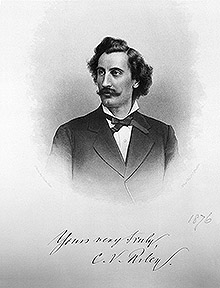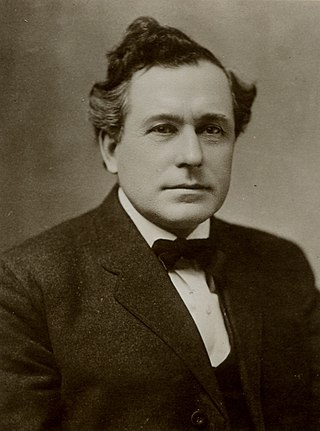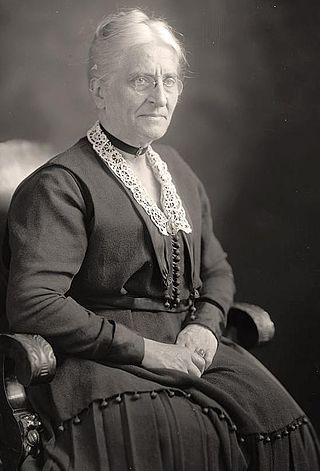Related Research Articles
Ross Harold Arnett Jr. was an American entomologist noted for his studies of beetles, and as founder of the Coleopterist's Bulletin.
Michael Charles Thomas was an American entomologist who co-authored the book series American Beetles.

Hermann August Hagen was a German entomologist who specialised in Neuroptera and Odonata. He had established himself as one of Europe's preeminent entomologists by 1867 when he accepted a position at Harvard University to curate the Museum of Comparative Zoology. In 1870 he became the first entomologist in the United States to hold the formal title, Professor of Entomology.

Charles Valentine Riley was a British-born American entomologist and artist. He was one of the first individuals to use biological pest control and authored over 2,400 publications. He convinced Congress to create the United States Entomological Commission and was among the founders of the American Association of Economic Entomologists.

Carl Robert Osten-Sacken or Carl-Robert Romanovich, Baron von der Osten-Sacken, Baron Osten Sacken was a German-Russian diplomat and entomologist. He served as the Russian consul general in New York City during the American Civil War, living in the United States from 1856 to 1877. He worked on the taxonomy of flies in general and particularly of the family Tipulidae.

Charles Duncan Michener was an American entomologist born in Pasadena, California. He was a leading expert on bees, his magnum opus being The Bees of the World published in 2000.
Philip Hunter Timberlake (1883-1981) was one of the most prolific American entomologists of the 20th century. He was born on June 5, 1883, in Bethel, Maine, and died in 1981 in Riverside, California, where he had served as an Associate Entomologist in the Department of Entomology of the University of California, Riverside.

Alexandre Arsène Girault was an American entomologist specializing in the study of chalcid wasps. An eccentric and controversial figure, Girault was also a prolific and dedicated entomologist. He published more than 325 papers and described over 3000 new taxa from Australia.

Andrew Delmar Hopkins was an American entomologist of the late 19th and early 20th centuries. Though self-taught, his scientific understanding of forest entomology was exceptional. He received an honorary doctorate from West Virginia University and in 1902 he went to work for the US Department of Agriculture. He was subsequently named head of the newly created Division of Forest Insect Investigations. He became a specialist in the bark beetle family Scolytidae, especially the genus Dendroctonus, species of which are the most destructive insects in coniferous forests of North America. His taxonomic monographs on these beetles are classics. He proposed the Law of Bioclimatics and he also developed the Hopkins Notes and Records System, a system he brought into the federal government when he first came to work for the Division of Entomology in the late 1890s. Hopkins’ research is one of the cornerstones of entomology on the North American continent and he is often referred to as the “father of North American forest entomology.”

Clara Southmayd Ludlow (1852–1924) was an American entomologist, the first woman known to publish extensively on the taxonomy of mosquitoes and their occurrence in relation to the incidence of mosquito-borne diseases. She made important contributions to the field of medical entomology and served as head of the Department of Entomology at the Army Medical Museum from 1920 until her death.

Harrison Gray Dyar Jr. was an American entomologist. Dyar's Law, a pattern of geometric progression in the growth of insect parts, is named after him. He was also noted for eccentric pursuits which included digging tunnels under his home. He had a complicated personal life and along with his second wife he adopted the Baháʼí Faith.

Charles Henry Tyler Townsend was an American entomologist specializing in the study of tachinids (Tachinidae), a large and diverse family of flies (Diptera) with larvae that are parasitoids of other insects. He was perhaps the most prolific publisher of new tachinids, naming and describing some 3000 species and genera. He made important contributions to the biological control of insect pests and he was the first to identify the insect vector of a debilitating disease in Peru. Townsend was also a controversial figure and criticism of his approach to insect taxonomy continues to this day.
Edgar Harold Strickland was an English army colonel and entomologist who specialized in flies and was the founding entomologist at the University of Alberta.

John Merton Aldrich was an American entomologist. Aldrich was the Associate Curator of Insects at the United States National Museum. He is considered one of the most prolific entomologists in the study of flies.
Maulsby Willett Blackman (1876–1943) was an American entomologist.
Gordon Gordh is an American entomologist.
Donald Robert Whitehead (1938–1990) was an American entomologist, who specialized in the study of the biogeography and systematics of weevils.
Donald Ray Davis was an American entomologist, specializing in Lepidoptera.
Herbert Barker Hungerford was an American entomologist and professor at the University of Kansas who specialized in the taxonomy, systematics and ecology of aquatic bugs in the families Corixidae and Notonectidae.

Hong-Fu Chu was a Chinese entomologist known for his pioneering work in establishing entomology in China. He was a specialist on insect immatures and was among the pioneers in the use of chaetotaxy in the classification of lepidopteran larvae.
References
- 1 2 "Biography". Smithsonian Institution Archives . Retrieved June 11, 2012.
- ↑ "Donald M. Weisman". Legacy. Retrieved 7 May 2017.